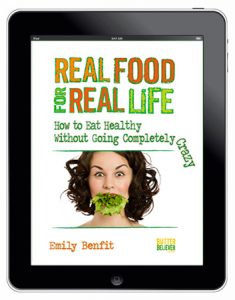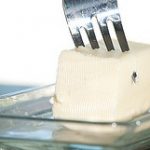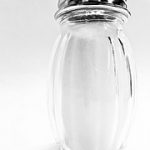“MyPlate” is the USDA’s most recent incarnation of the government nutrition recommendations, but is it any better than the old pyramid? Is MyPlate a good way to stay on track nutritionally, and can you trust it?
Well, understandably, many of us in the real food world who are so vocally opposed to government agencies messing with the sustainability of our food system, weren’t super thrilled to see more advice from the USDA telling us what to eat, when MyPlate was introduced in June of 2011.
And when MyPlate first came out, I’ll admit, I barely even glanced at it before writing it off as more of the same nonscientific BS nutrition recommendations the government has been dishing out for decades with the “food pyramid” diagrams.
Recently though, I finally gave MyPlate a second look—and I actually have a different opinion now. Are you ready for this? (Well, okay, I guess if you read the headline for this post, you’ve probably figured it out.)
I don’t think the government nutritional guidelines in MyPlate are all that bad.
Actually, I think MyPlate is a pretty good starting point for developing healthy, balanced eating habits. Hear me out, you guys. You might even agree with me once you look at these recommendations objectively.
Where MyPlate Gets it Right
Yes, MyPlate guidelines are actually right when it comes to a number of things. Let’s take a look at the basics of it, and see where the recommendations stand.
Emphasis on Whole Foods
The basic staples of the daily MyPlate diet for an adult look like this:
- 2 cups fruits
- 2 1/2 to 3 cups vegetables
- 6-8 ounces grains, at least half being whole grains
- 5-6 ounces protein sources—such as meat, eggs, seafood, nuts, seeds, beans, legumes, and/or (unfortunately) soy products
- 3 cups calcium-rich dairy products—milk, cheese, yogurt, etc.
As you can see on the actual “plate,” a MyPlate meal appears quite balanced between these food groups:
What counts for each of those portions on the plate? Here’s the recommendations for each:
- Fruits: “Any fruit or 100% fruit juice counts as part of the Fruit Group. Fruits may be fresh, canned, frozen, or dried, and may be whole, cut-up, or pureed.” (source)
- Vegetables: “Any vegetable or 100% vegetable juice counts as a member of the Vegetable Group. Vegetables may be raw or cooked; fresh, frozen, canned, or dried/dehydrated; and may be whole, cut-up, or mashed.” (source) Veggie categories include: Dark Green Vegetables, Starchy Vegetables, Red & Orange Vegetables, and Beans & Peas.
- Grains: “Any food made from wheat, rice, oats, cornmeal, barley or another cereal grain is a grain product. Bread, pasta, oatmeal, breakfast cereals, tortillas, and grits are examples of grain products.” (source)
- Protein Foods: “All foods made from meat, poultry, seafood, beans and peas, eggs, processed soy products, nuts, and seeds are considered part of the Protein Foods Group. Beans and peas are also part of the Vegetable Group.” (source)
- Dairy: “All fluid milk products and many foods made from milk are considered part of this food group. Most Dairy Group choices should be fat-free or low-fat. Foods made from milk that retain their calcium content are part of the group. Foods made from milk that have little to no calcium, such as cream cheese, cream, and butter, are not. Calcium-fortified soymilk (soy beverage) is also part of the Dairy Group.” (source)
So, aside from the “processed soy” stuff from the protein category, the “fat-free or low-fat”-ness of the dairy (more on that later), and the grains category which states that any food “made from” grains counts as a grain product (which includes some more processed fare), we’re mostly dealing with whole, healthy foods here.
Regarding those grains, though, MyPlate says: “Make at least half your grains whole grains.” I agree that this is a good idea for most people! I would add that they should ideally be sprouted, soaked, or soured whole grains, but whole grains in general do offer many beneficial nutrients that are lacking in refined grains. I don’t have a problem with eating moderate amounts of refined grains (such as white rice and even—gasp!—white flour), but I think balancing grains between whole and refined is a good choice.
Good Balance
In the old USDA food pyramid, some food groups were vastly emphasized over others—like this huge chunk of “Bread, Cereal, Rice, and Pasta” holding up the foundation of the supposedly ideal American diet:
Compared with MyPlate, the old food pyramid used to promote eating twice the amount of grains as vegetables—a whopping “6-11 servings” of grains per day. I’m not at all anti-grain, but that seems excessive and imbalanced to me. And heavily influenced by the—*ahem*—heavily-subsidized grain industry.
Now, MyPlate wants you to “Make half your plate fruits and vegetables.” And how can you really argue with that? I don’t always follow this, but a plate of half fresh produce, paired with other balanced foods, is certainly a healthy one. Add in the more modest grains serving, plus a good amount of protein and dairy, and we’re very much on track for a nicely-balanced meal.
Acknowledges importance of calories
One last thing that earns MyPlate a good pat on the back in my book, is that they do a great job recommending that you eat enough food. When I signed up for the Super Tracker site, an online MyPlate program to track your eating, activity, and weight management, it told me I needed to eat approximately 2,000 calories daily if my activity level is between 30 and 60 minutes of moderate activity. That sounds about right for someone of my height and weight.
They also recommend 3 solid meals a day, plus two snacks. Even if you plug in that your aim is to lose weight, they’ll recommend a modest calorie deficit, but maintain the eating plan of 3 meals plus snacks every day. That’s a much healthier way to manage your weight than most of the diet plans out there. And it involves no restriction of any macronutrient—well, beyond the already-existing reduction of dietary fat recommended for everyone, regardless of weight. Which brings me to the issues MyPlate certainly does deserve some criticism for.
Where MyPlate Gets it Wrong
While I don’t think the MyPlate guidelines are the worst thing ever, I do have a few gripes about the government’s nutritional recommendations.
Where’s the fat?
Did you notice how there’s no category on the Plate like there used to be at the top of the old pyramid for “Fats, Oils, and Sweets?” I was initially hopeful that the omission of fats in MyPlate was simply because it would be assumed that there are fats in your foods—in that glass of whole milk, with the butter on your rice and veggies, and in the juicy fattiness of your meats. Fat just comes with the program, right?
Uh, yeah. But then I snapped out of it and realized this is the USDA we’re talking about, here. Think they’re really on board with tasty fatty foods? Pshyeah. Right. They’re stuck in the 80’s like most of our fat-phobic society and want you to choke down boneless-skinless-tasteless chicken breasts, dry broccoli, watery rice, and skim milk.
So, let me just go ahead and fix that part for you, USDA! Here’s an updated, Butter Believer-approved MyPlate with an ever-so-slight deviation from the original:
But, they did have this to say regarding fats and oils:
“Oils are NOT a food group, but they provide essential nutrients. Therefore, oils are included in USDA food patterns.”
Right you are, USDA! Oils and fats do indeed provide very essential nutrients—like, oh, say… fatty acids, for one. Duh.
While they don’t include an “oils” or “fats/sweets” portion like they used to at the top of the food pyramid, there is some (mis)information about oils on the MyPlate.gov website.
But at least they’re not blatantly demonizing fats on the diagram itself, like the previous pyramid that suggested you consume all fats “sparingly.” You actually have to dig around to find the little blip of info on the MyPlate website that states the bias against “solid fats” which says:
“All fats and oils are a mixture of saturated fatty acids and unsaturated fatty acids. Solid fats contain more saturated fats and/or trans fats than oils. Oils contain more monounsaturated (MUFA) and polyunsaturated (PUFA) fats. Saturated fats, trans fats, and cholesterol tend to raise “bad” (LDL) cholesterol levels in the blood, which in turn increases the risk for heart disease. To lower risk for heart disease, cut back on foods containing saturated fats, trans fats, and cholesterol.”
Whomp-whommp.
Okay, obviously we’re still peddling the same long-debunked lipid hypothesis crap. No big surprise there, I guess.
But whoa, USDA, you’re seriously going to lump saturated fats and trans fats into one “solid fats” category, as though they’re the same? Yikes!
While trans fats are generally toxic and can indeed contribute to heart disease, saturated fats are quite the opposite. Your body needs them to support the structure of cell walls, and overall metabolic function.
These days, of course, they’re all about those “heart-healthy” liquid oils over at the USDA. So, the recommendation for fat intake goes like this:
Most of the fats you eat should be polyunsaturated (PUFA) or monounsaturated (MUFA) fats. Oils are the major source of MUFAs and PUFAs in the diet. PUFAs contain some fatty acids that are necessary for health – called “essential fatty acids.” (source)
Double yikes!
Most of the fats you eat should most definitely not be PUFA. While yes, some amount of PUFA are “essential,” the dosage rather quickly turns toxic with increasing amounts of these fatty acids, causing metabolic and cellular damage, inflammation, and advanced aging.
Unfortunately, the bad fat recommendations don’t end there for MyPlate.
“Meat and poultry choices should be lean or low-fat.” While most grass-fed and pastured meats are naturally lower in fat, there’s no reason to intentionally seek out particularly lean meats.
“Most Dairy Group choices should be fat-free or low-fat.” Okay. Don’t even get me started on that one. Fat-free dairy is a big, fat scam.
So, sadly, the misinformation about fats from the folks at MyPlate does put a serious damper on its legitimacy as sound nutritional advice. However, if you’re into real food, the food categories that make it onto your “Plate” will naturally contain healthy fats throughout, so you can still use the diagram as a basic guideline for balanced meals. Just ignore the fine print about all those healthy fats which are vilified on the MyPlate website.
“Empty Calories”
Just like they lump together fake trans fats like Crisco, with real saturated fats like butter, the USDA groups together another set of totally dissimilar nutrients as though they were one and the same—added sugars, and the entire class of “solid fats” (which includes both fake trans fats, and natural saturated fats). They call these nutrients and foods “empty calories,” collectively. (source) And they want you to limit your intake of the “empty calories” to about a couple hundred calories’ worth per day.
I won’t argue that added sugars are nutritionally “empty,” but the fact that they provide extra caloric value is nothing to freak out over. However, sure, consuming processed foods with added sugars in moderation is best.
And I definitely agree that all the hydrogenated oils found in processed foods are devoid of any beneficial nutrition whatsoever. (I’d say it’s worse than being a source of “empty” calories, however. They’re not just empty, they’re very damaging.)
But solid fats such as coconut oil and animal-based fats as “empty” calories? As in, they don’t provide important nutrients, like vitamins and minerals?
Really.
Wanna know what kind of nutrition is in my grass-fed butter, USDA?
Well, it’s deeply-yellow in color, because the cows eat green grass, making the butter packed full of beneficial carotene and vitamin A. It also contains a good amount of vitamin E, and difficult-to-find vitamin K2.
It would be one thing if all that natural solid fats provided was just that—fat. And if that fat really did cause heart disease (which it doesn’t), then it would definitely make sense to consider it an “empty” source of calories to be limited or avoided.
But the reality is that healthy, whole, traditional sources of saturated (solid) fat are always accompanied by beneficial nutrients. So, this is a pretty big strike against the MyPlate—the healthy saturated fats in my diet are anything but “empty!”
No mention of food quality
Sadly, the USDA is not supportive of the independent food system, and the “Big Ag” industrial food complex is pretty much in bed with them. So, they won’t tell you to make sure your meat is grass-fed, or that your dairy is from pastured cows and preferably raw, or that your fruits and veggies come from small, sustainable farms and not doused in chemical pesticides. Nope. Meat is meat, milk is milk, and apples are apples to them (and the giant agribuisness complex they support).
Of course, we know better. Food quality matters. For nutrition, for our health, and for the sustainability of our food supply. It would be nice if the USDA cared to educate the public on these matters, but unfortunately I don’t exactly see that happening anytime soon. So, when considering the MyPlate recommendations, consider the quality and source of your food, too.
MyPlate: A decent start for nutrition advice overall
While I definitely have my bones to pick with the MyPlate recommendations, I still think that overall, the diagram and dietary structure itself is an okay foundation for nutritional choices. Add in a hefty dose of common sense, and the MyPlate guidelines really aren’t all that bad.
In fact, you only have to ignore just a few pieces of the MyPlate advice to get yourself to a diet I’d wholeheartedly recommend.
All you have to do is ditch the following advice from the MyPlate recommendations:
Eat lean meat.That’s just dumb. Eat normal, whole parts of animals, without purposely trying to get rid of the fat.Eat low-fat dairy.Equally nonsensical. Whole foods in their natural state—fats intact—are best. You can read more of my ranting about fat-free dairy here.Avoid all solid fats.Trans fats like margarine and Crisco? Sure, definitely get rid of those! But the other solid fats—natural saturated-based fats like butter, animal fat, and coconut oil—should be your primary source of fatty acids in the diet.Eat more PUFA.Yeah, no. Read more about why excessive PUFA is toxic (and yes, the USDA recommendations to replace solid fats with PUFA counts as excessive) here.
And then of course, add in the following real food principles:
- Eat local and sustainably-farmed foods whenever possible
- Consume unprocessed foods with healthy fats intact
- Don’t be afraid of saturated fat! Do watch intake of PUFA
- Make the grains you eat even more nutritious and digestible by sticking with the traditional practices of grain preparation—sprouting, soaking, and souring (fermentation, as with real sourdough)
I certainly don’t think it’s perfect, as I’ve pointed out, but I really don’t think the basic structure of MyPlate is all that far-off from the whole foods perspective that we real food people recommend.
Really, if you just add in some healthy fats, traditionally-prepare your grains, and choose minimally-processed, sustainably-farmed sources of each of your food categories on that plate—it’s pretty much exactly what we promote. Balanced eating based in whole foods. That’s a big part of how I define healthy eating, and it just so happens to more or less fit the current government nutritional recommendations. Who’da thunk, huh?
 Want to learn more about nutrition basics, from a real food perspective?
Want to learn more about nutrition basics, from a real food perspective?
I’ve actually written a whole book about this very subject! 😉 Real Food for Real Life: How to Eat Healthy Without Going Completely Crazy, is my no-nonsense real food guide for the rest of us. I’m sure the USDA wouldn’t approve, but if you’re ready to graduate from the basics of “eat your fruits and veggies,” this is the stuff you really need to know. No stressful rules, no pressure to eat perfectly, and no guilt over that donut you just had to eat for breakfast. Just simple, sensible ways to get the nutrition you need, while eating the food you love, and maintain your sanity, too.
You can check out the ebook here to learn more.
What do you think of MyPlate?
Do you agree that it’s mostly OK advice, if taken with a grain of salt (and a pat of butter, perhaps)? Share your thoughts in the comments below.








Great post Emily! I usually stay away from everything the USDA says, but the “plate” isn’t so bad for people eating processed junk food most of the time.
I don’t think I’ll ever see the day the USDA says tio avoid PUFA though. Haha
The juice advice is pretty bad too. Also, I think the dairy is way over emphasized. If you ready the various brochures put out by the various sponsored of “my plate” it becomes very transparent that the nutritional advice is paid for by the industry that backs it. I cannot say that this is good advice, really at all. It seems to me that they incorporate allowance for the plate to be all processed foods.
I cannot agree that any part of this is good advice!
I think you’re forgetting that the USDA’s recommendations have to speak to all socio-economic levels of society, not just the educated and well-off middle and upper classes. Fact is, not everyone can afford to buy butter made from milk from grass-fed cows… or meat from pastured animals… or produce from small-scale, sustainable farms. The USDA’s guidelines are for the masses and I, for one, applaud their accessible (and unpretentious *cough, cough*) approach to raising awareness about healthy, balanced eating.
I also applaud their approach to healthy, balanced eating. That’s the point of this post.
I was a lot less offended by the “my plate” guidelines, when they came out, than most of my friends. To me, “my plate” looks a lot more sane and sensible than that pyramid with a massive base of grains. About 6 years ago, I had opportunity to consult with a dietician and she told me to basically load up my plates the way “my plate” demonstrates – 1/4 protein, 1/4 starchy carbs, and 1/2 veg and fruit. I think if we mentally substitute “starchy carbs” for the “grain” serving and understand the drink to be anything without loads of sugar or caffeine, it is a plan that works for nearly everybody.
Good read, and, by my book, a solid evaluation of the strengths and weaknesses of MyPlate (maybe missing the fact that is’s just a silly name).
Ok one question I have to folks of our ilk, especially when dealing with advice to others and not just ourselves. Do we really get to call the lipid hypothesis “long-debunked”? Yes, you believe it (its debunkedness), I believe it, we read about it and live by it, and it seems to work; but can we say it’s debunked? As of yet, current literature still paints a mixed picture. Yes, some of that refers to industrially-raised meat. Yes, some of it is funded by corporate interest. But who are we to know that the studies we want to believe are the only good ones, especially when it comes to other people’s bodies and health? (To your credit, I must at least admit that your post is not preachy; so I’m sorry, but I guess I’m probably lumping in more preachy and judgy writing / comments by others in with my reaction here.)
Maybe I don’t know enough about the research, but here are some examples of questions I might have before declaring full debunkedness. If you have answers & links I’d be glad to read more! Does the lipid hypothesis hold, even with healthily-raised animal fats, in folks with very sedentary lifestyles? Does it hold with certain other dietary conditions, such as high grain consumption, high sugar consumption, or anything else you might think of? Basically, while I do generally believe that for most folks eating real food, good SFAs make up a good part of a healthy diet, I (a) don’t know this, and (b) don’t know that it applies to everyone. Can you say otherwise?
Ok, off my little rant; I still liked your take on it overall! Interestingly, btw, there is research emerging that suggests that not all trans fats are alike; specifically, the naturally-occurring trans fast in ruminant animals may have no effect or even the inverse effect of trans fats in hydrogenated vegetable oils on coronary heart disease risk (in this study the trend occurred in women but not men). Note that, if I’m interpreting the data correctly, SFA were still positively associated with coronary heart disease risk even though this study shows a protective effect of animal products (so one couldn’t really make the industry propaganda claim here), but the study did not directly address this as its main question.
I want to thank you for this article! I’m a college student taking a required nutrition class that’s based around the MyPlate method of diet analysis. I’ve been becoming more and more skeptical as the semester has progressed, and I reached my breaking point last week when we talked about fats. I finally decided to do some more research when I found this article. I’m glad I’m not the only one who thinks replacing real dairy fat with sugar/sodium can’t possibly be healthier!
I think MyPlate is a great way to get the conversation started for the vast majority of Americans, and I agree it’s certainly better than the food pyramid I was taught in elementary and middle school.